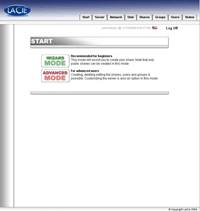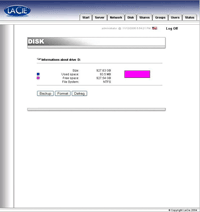SMB NAS Roundup
by Ross Whitehead Jason Clark Dave Muysson on December 5, 2006 3:30 AM EST- Posted in
- IT Computing
LaCie Ethernet Disk 1TB
The LaCie Ethernet Disk 1TB is a different type of NAS product. It is targeted at SMB/SOHO as a secondary storage device for holding backups and sharing temporary data. It is power by an 800Mhz VIA C3 processor running Windows XP Embedded, 256MB RAM, four USB 2.0 ports, one VGA port, two PS/2 ports, and one 10/100/1000 Network port. All drives are internal to the unit which cannot be opened. Features include FTP and HTTP accessible shares, onboard firewall, and backup scheduler. Client support includes Windows, Linux, Mac, and UNIX up to 25 users. Protocol support includes CIFS/SMB, AppleTalk/AFP, FTP, and HTTP.
Additional research revealed that there are four 250GB IDE hard drives configured using Windows Dynamic Volume in a span of all four drives. This gives you roughly 930GB of usable space, but with no RAID capabilities or redundancy. Additional storage space can be added through the USB 2.0 ports in the back of the unit.
Some of you may be wondering why we included it in this NAS review. Technically speaking it is a NAS device; it just doesn't have any redundancy built into. From a backup perspective, it will work just fine, providing you use it as a secondary storage device. It gives you with a lot of space, performs fairly well, and fits nicely in a rack. There really are a lot of scenarios you can use it in, but it would have been nice if we had the option to reconfigure the drives into a RAID 1 or RAID 5 since Dynamic Volumes supports this via software.
The unit is closed in a standard 19" 1U chassis with front mounting brackets only. Dimensions measure 430mm (W) x 45mm (H) x 430mm (D), and it weighs 9.3Kg. The front includes an illuminated power button as well as two LEDs indicating current disk/network activity. The rear includes connections for the power supply, PS/2 keyboard and mouse, video, serial, four USB 2.0 ports, and Gigabit networking. It also has what looks like audio jacks, but we were unable to verify their function.
Admin Interface
The management interface for the LaCie is primarily web based, with most of the supported features and options available through a browser. However, LaCie also included the ability to use Remote Desktop to log into the unit and run additional tasks such as backup and restore, firewall configuration, and additional diagnostics.
Pros
The LaCie Ethernet Disk 1TB is a different type of NAS product. It is targeted at SMB/SOHO as a secondary storage device for holding backups and sharing temporary data. It is power by an 800Mhz VIA C3 processor running Windows XP Embedded, 256MB RAM, four USB 2.0 ports, one VGA port, two PS/2 ports, and one 10/100/1000 Network port. All drives are internal to the unit which cannot be opened. Features include FTP and HTTP accessible shares, onboard firewall, and backup scheduler. Client support includes Windows, Linux, Mac, and UNIX up to 25 users. Protocol support includes CIFS/SMB, AppleTalk/AFP, FTP, and HTTP.
Additional research revealed that there are four 250GB IDE hard drives configured using Windows Dynamic Volume in a span of all four drives. This gives you roughly 930GB of usable space, but with no RAID capabilities or redundancy. Additional storage space can be added through the USB 2.0 ports in the back of the unit.
Some of you may be wondering why we included it in this NAS review. Technically speaking it is a NAS device; it just doesn't have any redundancy built into. From a backup perspective, it will work just fine, providing you use it as a secondary storage device. It gives you with a lot of space, performs fairly well, and fits nicely in a rack. There really are a lot of scenarios you can use it in, but it would have been nice if we had the option to reconfigure the drives into a RAID 1 or RAID 5 since Dynamic Volumes supports this via software.
The unit is closed in a standard 19" 1U chassis with front mounting brackets only. Dimensions measure 430mm (W) x 45mm (H) x 430mm (D), and it weighs 9.3Kg. The front includes an illuminated power button as well as two LEDs indicating current disk/network activity. The rear includes connections for the power supply, PS/2 keyboard and mouse, video, serial, four USB 2.0 ports, and Gigabit networking. It also has what looks like audio jacks, but we were unable to verify their function.
 Front |
 Rear |
| Click to enlarge | |
Admin Interface
The management interface for the LaCie is primarily web based, with most of the supported features and options available through a browser. However, LaCie also included the ability to use Remote Desktop to log into the unit and run additional tasks such as backup and restore, firewall configuration, and additional diagnostics.
 Web Interface - Status |
 Web Interface - Disks |
| Click to enlarge | |
Pros
- Simple interface
- Decent performance
- Quiet
- No RAID/Data protection
- No Redundant Power or NIC
- No SMB features like DHCP Server, Print Server, AD integration, Alerts, etc.










23 Comments
View All Comments
dropadrop - Monday, December 11, 2006 - link
How was the noiselevel measured for the device? I was considering the Intel since it's easily available here, but previous reviews have stated it was far from silent. Here's a quote from toms:I'm pretty allergic to noise, currently the noisiest thing I have is a Buffalo Linkstation, which I have allready stuffed in a closet and end up turning off when not used.
eaglemasher - Monday, December 11, 2006 - link
I've had an infrant readynas NV running for about 10 months, and I am impressed with the overall experience. The access speeds are much faster than my other NAS device, the firmware updates are very regular, the support staff are responsive, and it's quiet. Then there's the fact that it supports pretty much any network file system you want to throw at it and supports long path lengths and I am one very satisfied customer. Perhaps Infrant's hardware is hit and miss for some people, but in my case I haven't had a hiccup in 10 months of constant use as a backup device for 18 users.My other raid NAS device is a Terastation I've run for about 20 months. My overall assessment is stay the heck away. The only good thing I can say about it is that it hasn't failed yet, but the speeds are pretty dismal, the interface is very limiting, and the path length limitations make it unusable as a direct-copy backup device. Add to that the fact that Buffalo has not updated the U.S. firmware in 1 1/2 years (though the japanese version gets regular updates), and it's extremely disappointing, especially when contrasted with the ReadyNas. Maybe with the firmware updates the Japanese actually get a useful NAS.
archcommus - Wednesday, December 6, 2006 - link
I'm not too familiar with these devices, can someone tell me what advantage(s) they hold over a home built file server PC? Something cheap and slow but with a large hardware-based RAID array that simply sits in a room with no monitor attached and does its job. Seems that'd be easier and more upgradeable, also probably faster.yyrkoon - Wednesday, December 6, 2006 - link
They hold no real benifit over home built solutions, except that perhaps, like buying a Dell PC, you dont have to build/provide support for it yourself. For a home brew solution, you can use whatever you like, however you like, and dont have to worry about proprietary hardware. Granted, OEMs have more experience in this arena, so when you do build your own, you may have to learn what works, and what doesnt, on the fly.Anyhow, thats the way I see it, maybe someone else can answer further if I missed something.
TheBeagle - Wednesday, December 6, 2006 - link
I know that evaluators are most times constrained by time limits for their work, but I believe you guys missed a very good NASA box offering along the way. I'm speaking about the latest offering from U.S. Robotics, Model 8700. It is a four-bay box, with gigabit ethernet connection, 2 additional USB 2.0 ports, and is very well constructed. It comes without any drives, which allows the vendor/user to select their own drive (WD500YS drives work great in it), and can array four drives of 500 GB each into a RAID 5 setup that works like a charm. It has good software and also client backup software. You really ought to evaluate this NAS box as well. It's a winner!mziegler - Tuesday, December 5, 2006 - link
I'm really glad to see this type of review as I have been looking at these devices. However, the review left out any drive failure scenerios. I would like to see included in the review of the Hammer system restoring or rebuilding a RAID array using the Z-FS file system. Also for that system since it uses a proprietary file system a test of grabbing data off of a drive using Dataplows SFSExtract.exe DOS utility.This review focused solely on performance which is only about half the reason someone would purchase one of these devices. The redunduncy which arguably is most important was practically ignored.
A review of this type of product in my opinion must answer the following questions:
- What happens if a drive fails
- What happens if the NAS device fails
- How easy and how long is the recovery process
- What's the relative performance
- Features vs a traditional Unix/Linux/WS2003 NAS head
LoneWolf15 - Wednesday, December 6, 2006 - link
Insightful post. I agree with the parent poster on this one.aikend - Tuesday, December 5, 2006 - link
It would have been really nice if the features table had included the maximum number of drives, and maximum total capacity, for each of the units. Sure, I can go to each vendor's website and track it down by myself, but I would think "disk capacity" would be a pretty important measure for lots of people.JarredWalton - Tuesday, December 5, 2006 - link
Disk capacity will often be determined by the largest HDD available. Right now, that's the Seagate 750GB, so you can do up to 3TB of storage in a four drive unit (which most of these are). When someone makes a larger HDD, there's a pretty good chance all of these NAS units will support it. I'm not sure where the next "barrier" is on SATA/BIOS/OS drive sizes, but after the 128GB limitation was removed I think the next maximum HDD size went up into the many TB range.yyrkoon - Tuesday, December 5, 2006 - link
I've been told that the next limit barrier of 48 bit LBA is more than 2 TB per disk, although, I havent personally read any specifications concerning this. This also isnt to say, that other factors couldnt come into play either (manufactuer using cheaper electronics, and thus reducing the over all limit somehow).